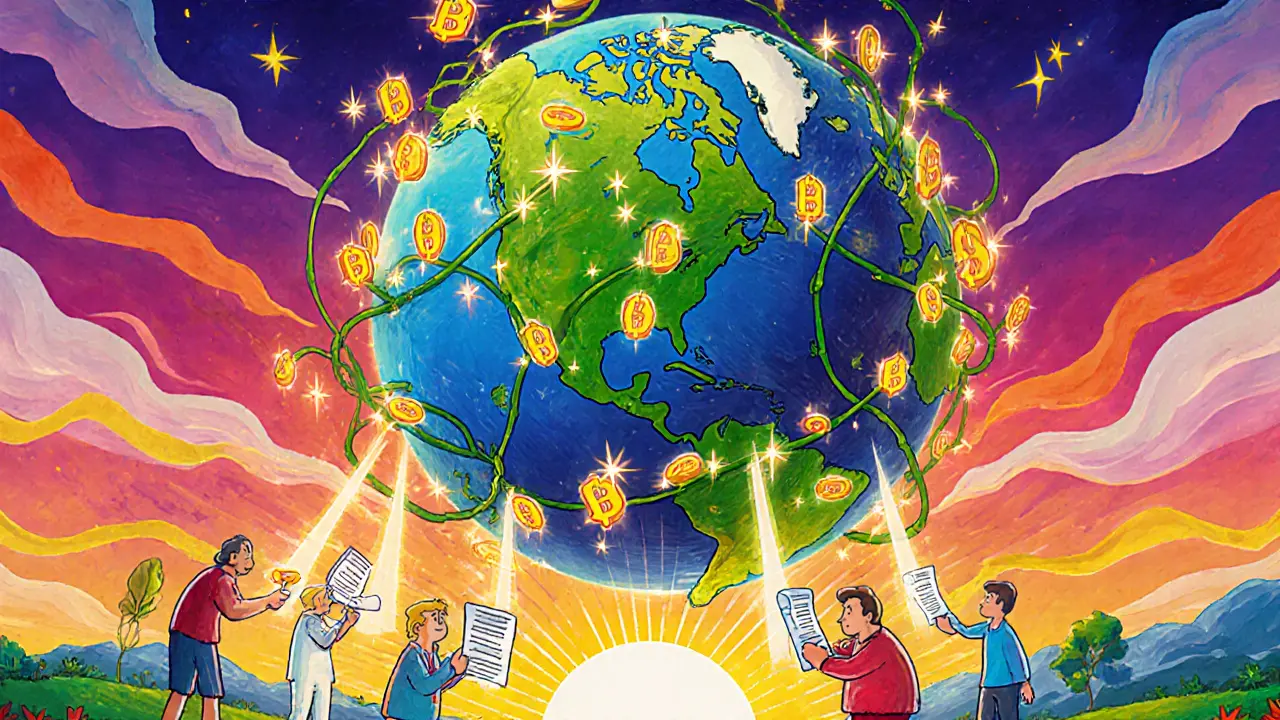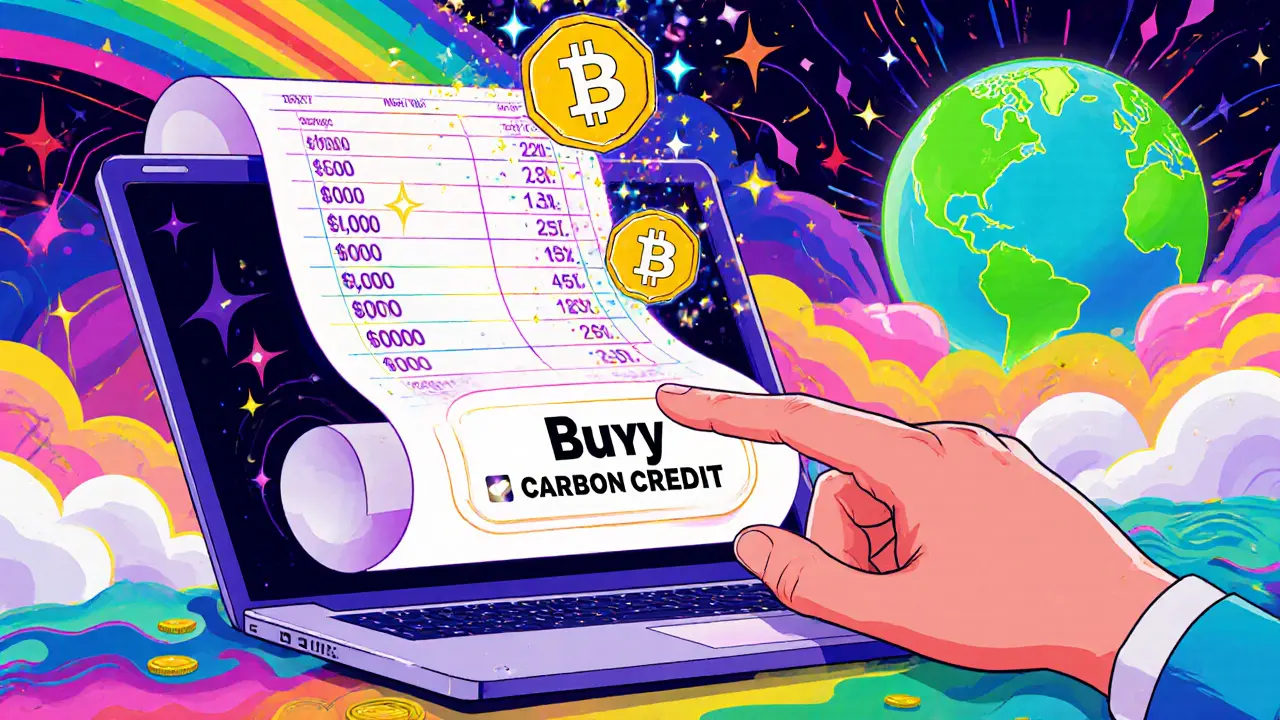Carbon Credit Calculator
Calculate Your Carbon Offset Needs
Enter your emissions to see results here
Imagine buying a carbon offset with a single click, watching its token move on a ledger that anyone can audit. That’s the promise of carbon credit blockchain projects - a blend of climate finance and distributed ledger tech that aims to make carbon markets as easy to navigate as DeFi.
Carbon Credit Blockchain Projects are initiatives that digitize, trade, and retire carbon credits on a blockchain. By converting traditional verification certificates into crypto‑style tokens, these platforms try to solve three long‑standing problems: opacity, illiquidity, and double‑counting.
Kyoto Protocol is the 1997 UN treaty that launched the first international carbon credit mechanisms, laying the groundwork for today’s tokenised markets.
Why blockchains could change the carbon market
Traditional carbon markets rely on paper trails, manual registries, and bilateral deals that can hide fees and delay settlement by weeks. A blockchain provides an immutable, time‑stamped record that anyone can query, which brings three core advantages:
- Transparency: Every token’s origin, ownership history, and retirement status is viewable in real time.
- Liquidity: Tokens can be fractionated and pooled, allowing small buyers and large institutions to trade on the same market.
- Automation: Smart contracts handle settlement, retirement, and even price discovery without a middleman.
Major players in the space
Several projects have taken the concept from theory to production. Below is a quick look at the most active platforms.
Toucan Protocol is a pioneering platform that launched in October 2021. It was the first to tokenise carbon credits into ERC‑20 tokens called TCO2. Within six months it had tokenised more than 20 million tonnes, proving strong demand. Toucan issues two main token types: Base Carbon Tonnes (BCT) for DeFi integration and Nature Carbon Tonnes (NCT) aimed at corporate buyers.
Klima Protocol builds on Toucan’s infrastructure to provide a liquidity hub. KlimaDAO manages a pool of roughly 20 million tokenised credits, allowing users to buy, sell, or retire BCT directly from a decentralized exchange. Its smart contracts automate price discovery and retirement, making carbon offsets as tradable as any other crypto asset.
AirCarbon Exchange (ACX) offers a full‑stack marketplace that records each credit on‑chain, links it to recognised registries, and provides real‑time valuation tools. By creating immutable ownership records, ACX reduces the risk of double counting and gives traders confidence in the underlying asset.
Carbonmark focuses on on‑chain liquidity and developer APIs. Its platform lets businesses embed carbon offset purchases into apps, wallets, or fintech services, turning sustainability into a programmable feature.
EcoRegistry uses distributed ledger technology to register credits from issuance to retirement. It integrates with existing standards, offering a “digital twin” of each certificate that can be audited by regulators or auditors.
International Carbon Registry (ICR) is an open‑source registry designed specifically for digitally native credits. Its blockchain‑based system enables seamless movement of tokens across platforms, tackling the fragmentation that has plagued legacy markets.
Puro.Earth specialises in engineered removals such as biochar and mineralisation. It verifies projects on‑chain and sells digital credits to corporations like Microsoft and Shopify, providing a clear path for permanent carbon storage.
How tokenisation works under the hood
All of these platforms follow a similar technical flow:
- Verification - A third‑party registry confirms that a real‑world project has removed or avoided one tonne of CO₂.
- Retirement - The verified credit is “retired” on the registry to prevent double counting.
- Bridging - A bridge contract locks the retired credit and mints a corresponding on‑chain token (e.g., BCT or TCO2).
- Trading - Tokens can be listed on DEXs, pooled, or fractionalised. Smart contracts enforce rules such as minimum holding periods or automatic retirement on demand.
- Retirement on‑chain - When a buyer wants to offset emissions, a smart contract triggers the retirement of the underlying credit and burns or locks the token, providing an immutable proof of offset.
This process retains the original verification data on‑chain via metadata, ensuring that each token carries its provenance.

Key benefits observed in practice
- Price discovery: Market participants can see real‑time bid/ask spreads, unlike opaque bilateral deals.
- Reduced transaction costs: Automated settlement cuts out brokers, saving 1‑3 % of the trade value.
- Programmable offsets: Companies can set smart contracts to automatically purchase and retire credits whenever emissions cross a threshold.
- Access for small players: Fractional tokens let individuals buy 0.01 tCO₂, opening the market to retail investors.
Challenges that still need fixing
Despite the hype, several hurdles remain:
- Quality control: Toucan’s early surge included low‑quality or dormant credits, prompting some registries to temporarily block tokenisation.
- Double‑counting risk: Ensuring that a tokenised credit is retired on the original registry is technically complex and requires robust bridging protocols.
- Regulatory uncertainty: Jurisdictions differ on how to treat tokenised carbon assets, creating compliance headaches for firms.
- Standardisation: No universal token schema exists yet, leading to fragmentation between ERC‑20, Cosmos, and other chains.
- Energy consumption: Some blockchains (e.g., proof‑of‑work) add carbon emissions of their own, undermining the environmental goal.
Comparison of leading platforms
| Project | Primary Token | Blockchain | Liquidity Mechanism | Notable Partners |
|---|---|---|---|---|
| Toucan Protocol | BCT / NCT (ERC‑20) | Ethereum (L2) | Pool + DeFi integration | Microsoft, Shopify |
| Klima Protocol | BCT (ERC‑20) | Ethereum (L2) | DAO‑managed pool | Polygon, Aave |
| AirCarbon Exchange | ACX‑CO2 (ERC‑20) | Ethereum & Polygon | Order‑book & OTC desk | World Bank, IBM |
| Carbonmark | CMK (ERC‑20) | Ethereum | API‑driven liquidity | FinTech platforms |
| Puro.Earth | Puro‑CO2 (ERC‑20) | Ethereum | Project‑specific pools | Microsoft, Shopify |

Real‑world use cases
Corporate teams are already plugging these tokens into their ESG workflows. For example, a multinational retailer integrated Carbonmark’s API to automatically purchase NCT each time a shipping container passed a carbon threshold, resulting in a 15 % reduction in reported Scope 3 emissions within a year.
Microsoft’s “Carbon Negative” pledge leans on Puro.Earth’s digitally verified removals, using blockchain proofs to demonstrate that each tonne of biochar is permanently stored.
DeFi projects have begun offering yield farms that reward users in BCT, turning carbon offsets into an on‑chain incentive for liquidity providers.
Future outlook and best‑practice checklist
Analysts expect tokenised carbon volumes to hit 150 million tonnes by 2030, driven by stricter ESG reporting and growing DeFi integration. To stay ahead, participants should follow this quick checklist:
- Verify that the bridge protocol retires credits on the source registry before minting.
- Prefer platforms that publish on‑chain provenance metadata (origin project, vintage year, verification standard).
- Watch for emerging standards such as the Carbon Credit Token Standard (CCTS) that aim to harmonise token schemas.
- Assess the underlying blockchain’s energy profile - L2 solutions and proof‑of‑stake chains are preferable.
- Maintain a diversified pool of credits to avoid concentration risk in a single registry.
Wrapping up
Carbon credit blockchain projects are still early‑stage, but they already demonstrate how immutable ledgers can bring the carbon market into the digital age. By partnering with reputable registries, adopting transparent token standards, and integrating smart‑contract automation, these platforms are turning a niche climate‑finance tool into a mainstream financial primitive.
What is the difference between BCT and NCT?
BCT (Base Carbon Tonnes) is a generic token used mainly for DeFi composability, while NCT (Nature Carbon Tonnes) is tied to nature‑based projects and is marketed directly to corporate offset buyers.
Can I retire a tokenised credit on‑chain?
Yes. Most platforms include a retirement function in their smart contracts that permanently locks the token and updates the source registry to reflect the offset.
How does double counting get prevented?
The bridge contract first retires the credit in the original registry, generating a cryptographic proof that the same tonne cannot be sold again. This proof is stored on‑chain alongside the token.
Are blockchain carbon credits regulated?
Regulation varies by jurisdiction. Some regions treat tokenised credits as securities, while others view them as digital assets. Companies should consult local AML/KYC rules and emerging guidance from the EU’s MiCA framework.
Which platform offers the best liquidity?
Klima Protocol’s DAO‑managed BCT pool currently provides the deepest order‑book, but AirCarbon Exchange offers both on‑chain and OTC options for large institutional trades.

Write a comment